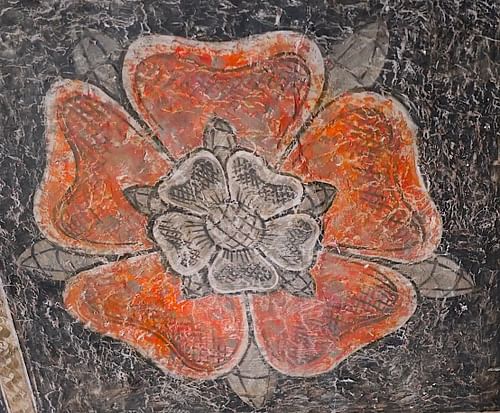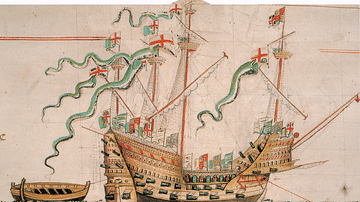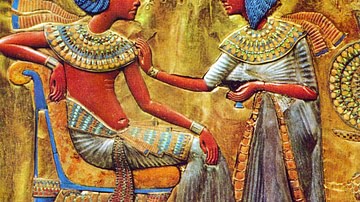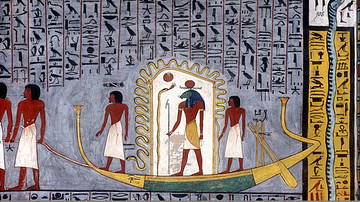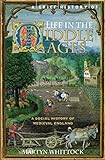The rose that grows in many different forms in gardens all over the world today is an evolution of rose-like plants that lived in the northern hemisphere between 33 million and 23 million years ago. Traces of them have been found in the fossil record of the Oligocene epoch in Europe, Asia, and western North America.
The climate in those times was largely temperate with plentiful insect life, conditions that are still favoured by roses today. Five-petaled flowers, distinctive oval serrated leaves and colourful hips – characteristics that can be found in wild rose species today – differentiated them from other plant remains when the fossils were examined.
Mythological Origin & Symbolism
According to Greek mythology, the goddess of flowers, Chloris, created a new flower by breathing life into a woodland nymph who had died. Dionysus, the god of wine and plant life gave it a beautiful perfume, and Aphrodite, the goddess of beauty and pleasure, gave the rose its name by rearranging the letters of Eros, her son and the god of love and desire. Eros later gave a rose to Harpocrates, the god of silence, as a bribe to ensure he kept the indiscretions of the gods to himself. Hence, the rose became symbolic of secrecy, silence, and love. This story was carried on into Roman mythology, with the protagonists replaced by their gods, Flora, Venus, Cupid, and Bacchus, although Harpocrates retained his Greek name.
The association with secrecy led to the rose becoming a visual symbol of the need for discretion. Roses were carved into the ceilings and walls of public rooms in grand houses, courtrooms, and Catholic confessionals as a reminder that all conversations should be kept confidential. From the Middle Ages, a rose was often suspended from the ceiling of a government council chamber to ensure the secrecy of proceedings. Therefore, sub rosa ("under the rose") became a quasi-legal term still in use to denote something that is best kept under wraps.
Discovery of the Earliest Rose
The first rose species to be described for science came from the Florissant Fossil Beds in Teller County, Colorado USA. In 1883, paleobotanist Charles Leo Lesquereux wrote a scientific paper Contribution to the Fossil Flora of the Western Territories in which he described and named Rosa hilliae, the simple rose-like specimen he had received amongst samples collected by Hayden's US Geological Survey and the Princeton Scientific Expedition of 1877.
His choice of name was to honour the amateur palaeontologist Charlotte Hill, who first brought the Florissant Fossil Beds to science's attention. She lived with her family on a homestead, the Petrified Stump Ranch, c. 3 kilometres (2 mi) south of the town of Florissant. Charlotte began collecting fossils of plants and insects that she found when digging the land around their property and became fascinated by them, eventually building up a small museum and hosting many renowned geologists and palaeontologists to whom she gave parts of her collection.
Evolution of the Rose
Nowadays, the genus Rosa encompasses around 150 species of erect, climbing, or trailing perennial shrubs with thousands of varieties. These stem from a very small number of original roses from Asia that were crossbred over the centuries with native European and American wild species.
Roses are classified into three types:
- species – the familiar 'wild rose'
- Old World roses – introduced before 1867)
- modern roses
The first species roses had five single petals as seen on the flowers of Rosa hilliae. These are the species that formed the genetic building blocks for our modern-day roses. They include the dog rose, Rosa canina, which is commonly found in hedging. There is also the Scotch rose, Rosa pimpinellifolia, a tough, bushy rose that survives well in exposed or seaside locations, Rosa gallica, which comes from warmer southern Europe, Rosa carolina from the eastern US and Rosa blanda that toughs it out on the American prairies.
The process of turning the wild rose into a garden plant of infinite variety began a long time ago. The first domesticated roses may have been deliberately cultivated as early as 3,000 BCE in China. They were used in the making of rosewater and in perfumed oils, for medicinal purposes and as confetti for celebrations. The philosopher Confucius recorded that roses were growing in the gardens of the Imperial Palace in 500 BCE and the Chinese emperor's library contained a large number of books on the subject. China was the sole source of yellow roses and all their present-day descendants, as there are no wild roses in Europe with that colouration.
The ancient Egyptians bathed in rosewater and scattered rose petals to make their rooms sweet-smelling. The Romans grew roses extensively in large public gardens, and Rosa alba could be found in the gardens of nobles and monks in medieval Europe, widely thought to have been spread there by visiting Romans. Every medieval monastery had its botanist monk, cultivating roses alongside other plants and herbs to be used in religious ceremonies.
Also grown by medieval gardeners was Rosa damascena, or the damask rose, with its luxuriant double, deeply scented flowers. As its name 'from Damascus' suggests it was probably brought back to Europe from Syria by merchants in the 12th century or Crusaders in the 13th century, along with Rosa oficinalis, known as 'the apothecary's rose'.
It has been the continuing intervention of botanists and plant breeders that has transformed the wild rose into a consistent garden plant. Roses raised from seed do not retain the characteristics of their parents. Cuttings have to be taken to maintain a variety. So an old rose today can be said to be a living link with a rose that once grew in a medieval garden. Old roses often do not bloom for as long as their cultivated descendants, and their colours are more pastel and less showy. However, they are hardy and do not require the same degree of attention and maintenance as a modern hybrid. They also still exude the strong fragrances that come from their wild ancestors.
The Political Rose
From being purely decorative, roses gradually took on a more symbolic significance when they started to appear in the emblems of nobility. In the 13th century, the white Rosa alba was the badge of Eleanor of Provence, wife of Henry III of England. Her son Edmund, Earl of Lancaster, adopted the red Rosa gallica from his wife Blanche of Artois when they married. This established the red rose as the mark of the House of Lancaster.
More than 200 years later, Richard, Duke of York, chose the white rose as his badge. When the right to the crown of England was disputed by the House of Lancaster and the House of York between 1455 and 1487, the conflict became known as the War of the Roses. The resolution of that civil war resulted in the Lancastrian Henry Tudor being crowned King Henry VII of England. He married Elizabeth of York and united the symbolic white and red roses to form the Tudor rose. The form of this double rose can be seen carved extensively into Tudor buildings and furniture and painted into portraits of the time, symbolising for all time a united country.
As recently as 1986, the rose was chosen as the US's official national flower by popular vote. In a special ceremony, President Ronald Reagan signed into law the joint resolution issued by the Senate and the House of Representatives with the words:
More often than any other flower, we hold the rose dear as the symbol of life and love and devotion, of beauty and eternity… We see proofs of this everywhere. The study of fossils reveals that the rose has existed in America for age upon age. We have always cultivated roses in our gardens. Our first President, George Washington, bred roses, and a variety he named after his mother is still grown today. The White House itself boasts a beautiful Rose Garden. We grow roses in all our fifty States. We find roses throughout our art, music and literature. We decorate our celebrations and parades with roses. Most of all, we present roses to those we love, and we lavish them on our altars, our civil shrines, and the final resting places of our honored dead. (Proclamation 5574)
A National Collection
During the 15th and 16th centuries, rose growers began to breed and alter varieties such as R. damascena and its Middle Eastern cousin, Rosa centifolia. The Dutch were early pioneers, and modern research has shown that at least four species of wild roses can be found within the makeup of R. centifolia. The results of roses grown in Holland in the 16th and 17th centuries can be seen in paintings by the Dutch Old Masters. These depicted large double flowers with the distinctive 'cabbage rose' shape of R. centifolia. The flat-faced flowers look as if they have had their petals sliced across by a knife.
The golden age for roses has to be the early part of the 19th century. It was driven by Joséphine de Beauharnais, wife of Napoleon Bonaparte. When she bought the Château de Malmaison on the outskirts of Paris, Joséphine filled its gardens with all the known roses at the time. They were sent for from suppliers all over Europe. This was the time of the Napoleonic Wars and the Continental System, but it is said that special arrangements were made so that shipments of roses from England could make their way through the English Channel blockades unimpeded.
When the collection grew, Joséphine commissioned the painter Pierre-Joseph Redouté to record the roses. His published work, Les Roses, 1817-24, now forms the starting point for much of the modern scientific research into garden roses. The collection helped spark France's enthusiasm for the flowers, and there was a boom in rose breeding. In fact, nearly all the old roses we grow today were bred in France.
Jacques-Louis Descemet was one of four great French rosarians who cultivated roses around Paris at the time of Joséphine. He helped to popularise a variety that had been imported into France from Dutch rose breeders but became known as Rosa gallica (French rose) when it was subsequently sent from France to England. The origins of R. gallica are not clear, but it was known as a species by the Persians in the 12th century, and the Dutch cultivated it to an extent 400 years later, although their preference was for R. centifolia.
A Multitude of Hybrids
When repeat-flowering China roses first arrived in Europe around 1790, they gave rose breeders a fantastic new characteristic to work with: the ability to flower not once, but throughout the growing season. The next major step in the development of the rose came when hybridisers crossed the ancient China rose, Rosa chinensis, with the European Rosa gigantea. The result had a smell that was said to be reminiscent of a cup of China tea and so it was nicknamed the 'tea rose'.
Another crossing a few years later blended the damask rose with some other species roses that blossomed freely for many years and so were named hybrid perpetuals. The final chapter in this particular rose story was written in the mid-19th century when tea roses were crossed with hybrid perpetuals, and the hybrid tea rose was born. Its large flowers and vigorous long-lived flowering habit have made it the most popular type of rose in the world.
Bourbon roses arose from natural hybridisation between R. chinensis and a damask rose on the island of Ile Bourbon, better known now as the Island of Reunion, near Mauritius. It was an important port of call for reprovisioning French ships in the days before the Suez Canal. A seedling of the hybrid was taken from there to Paris in the early 19th century and further crossed with R. gallica. The resulting long-blooming roses, with their strong perfume, are still widely grown today.
The first American-bred hybrid group – the 'Noisette roses' – were first grown in the 1800s in South Carolina. A French nurseryman, Louis Noisette, sent a China rose of the variety 'Old Blush' to his brother Philippe, who was living in the States. Philippe passed the rose on to his neighbour John Champneys, who crossed it with a climbing musk rose, Rosa moschata, and the result was named 'Champneys' Pink Climber'. Seeds from that plant were sent back to France which then grew into a new climber they called Noisette Carnée, and further hybrids came about when these Noisettes were crossed with tea roses.
Into the 20th Century
Modern roses began with hybrid teas and were soon joined by floribundas and grandifloras. The former were cultivated in the late 19th century by the Dutch Poulsen company, still in existence today. Its hybridisers crossed dwarf China roses with small hybrid teas to produce compact shrubs with multiple clusters of small double flowers.
Grandiflora roses began life in the 1950s as crosses between hybrid teas and floribundas. These tall, hardy bushes with full-blossomed flowers are the most familiar garden roses today, but they do not produce the same level of fragrance as Old World roses. They are more standardised in form and more brightly and variously coloured, which is what makes them popular for an expansive garden display.
Nowadays, new hybrids spring up every year from many different growers around the world as the quest for the perfect rose goes on. Meanwhile, species roses keep the original gene pool alive and old roses maintain a loyal following, prized for their natural growth and strong perfume. History is continually being written in the world of rose cultivation.




